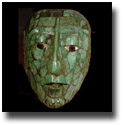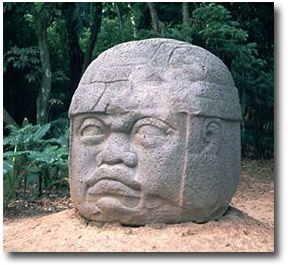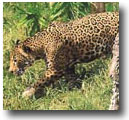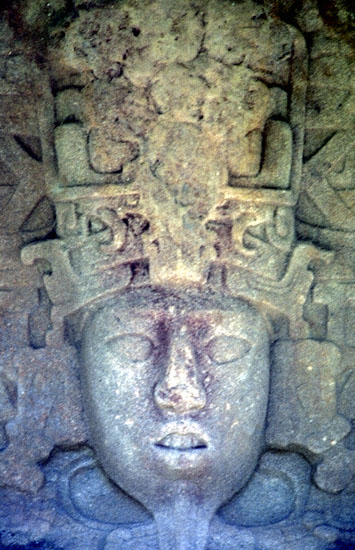|
Although jade has been primarily associated with the Chinese culture who have venerated the stone for more than 5,000 years, the name jade owes its origin to the cultures of ancient Mesoamerica. When the Spaniards conquered Mesoamerica in the early 16th century, they found many Aztec wearing the jade (jadeite derived from Guatemala) to ward off or cure kidney problems. This talismanic use inspired the Spaniards to call the gem: piedra de la ijada, or stone of the loins. Hence, the first European interest in jade did not arise from contact with China, but with the New World.
A defining element of Mesoamerican culture for 2500 years, jade served as currency, medicine, and a symbol of rank and political power. From the early-formative stages of the Olmec culture,
beginning around 1200 BC, thru the rise and fall of the great Maya & Aztec civilizations
ending with the Spanish Conquest of AD 1521, jade was the most treasured and
revered stone of the ancient Mesoamerican cultures. Jade was employed in social,
ritual and utilitarian contexts, and was also an item of prestige and ornament
much as it is today. It served as a tangible source of magic and power, and was
considered a symbol of both life and breath. It energized religion and politics,
appearing as both sacrament and insignia.
When the Spaniards conquered Central America in the early 16th century, they found many Maya people wearing jade to ward off or cure kidney problems. This talismanic use inspired the Spaniards to call the gem: piedra de l'ejade, or 'stone of the loins'. The Maya originally referred to the jade as quetzalitzli, a name derived from quetzalli [quetzal feather] and itztli [obsidian], because its appearance is similar in color to the green quetzal feather — the most sacred symbol of the Maya. The feathers of the quetzal bird, along with carvings fashioned from jade, were the most sought after treasures of the Maya elite.
Following the Spanish conquest, the locations of the jade mines in Guatemala were lost until their accidental rediscovery by a US geologist in 1954. Twenty years later, local businesses emerged vending jewelry products and replica artifacts to a tourist clientele. The pace of events accelerated dramatically in the autumn of 1998, when torrential rainfall associated with Hurricane Mitch exposed new deposits of high quality jade in the mountains of Guatemala.
The Stone of Kings
 Beautiful and numerous artifacts fashioned of jadeite are often found among the tomb sites of the Olmec, Maya and Aztec kings. To these ancient cultures, jade was both a symbol of religious or ceremonial significance, and an object of personal adornment, strength, and wealth. Beautiful and numerous artifacts fashioned of jadeite are often found among the tomb sites of the Olmec, Maya and Aztec kings. To these ancient cultures, jade was both a symbol of religious or ceremonial significance, and an object of personal adornment, strength, and wealth.
To these early cultures, jade represented an ideal treasure which was passed on through generations and revered as sacred heirlooms. It was the Stone of Kings, used as a measure of wealth and a tool of commerce for over three millennia.
In many early Spanish accounts, jade is commonly referred to as esmeralda, a term deriving from the precious as well as verdant quality of the stone. A direct participant in the conquest of Mexico, Bernal Díaz mentioned that:
"soon after delivering a rich treasure to Cortés at San Juan Ulua, an emissary of Moctecuzohma offered Cortés a group of extremely precious jades with other rare goods: he presented ten loads of fine rich feather cloth, and four chalchihuites, which are green stones of very great value, and held in the greatest esteem among the Indians, more than emeralds are by us, and certain other gold articles" — (Díaz 1956: 76). — From 'Conquest of Mexico', by Bernal Diaz Del Castillo, Conquistador
The Olmec were one of the earliest
known cultures of ancient Mesoamerica. Their people thrived during the Early
to Late Formative, pre-Classic period from 1200 to 400 BC. The Olmec are considered
to be the first pre-Columbian culture to associate wealth, prestige, and ritual
belief with the carving of jade. To these coastal dwellers, jade served as a
tangible and powerful symbol of life and breath. It was often fashioned into
objects used for both personal adornment and ceremonial significance. The heartland
of the Olmec culture was found in southern Mexico's Gulf Coast region of Veracruz
and neighboring Tabasco. The Olmec lived in a highly developed, sophisticated,
hierarchical society, unparalleled for their time in culture, the arts and science.
The Olmec made their homes of adobe, wood and palm leaf and constructed cities around a central raised clay mound or terrace. These central mound sites were the homes of their rulers and the center of ritual and ceremony. The ceremonial centers were often painted in bright shades of red, yellow, and purple with floors made of elaborate mosaics of stone and multicolored clay. Around 900 BC, the raised mound structures gave way to the development of massive earthen pyramids, the first known to exist in Mesoamerica.
 The Olmec are most notable for their colossal heads of stone, weighing some 20 tons or more, known to exist at San Lorenzo, La Venta and other sites. For San Lorenzo alone, there are ten colossal heads known, all carved before 900 BC. It is generally believed that these are monuments depicting specific Olmec rulers, with their characteristic thick lips and broad flat noses. In fact, two of the colossal heads from San Lorenzo show evidence of being recarved from thrones. Surprisingly, the quarry sites of these massive stones were often located up to eighty miles from the monuments final resting place. The Olmec are most notable for their colossal heads of stone, weighing some 20 tons or more, known to exist at San Lorenzo, La Venta and other sites. For San Lorenzo alone, there are ten colossal heads known, all carved before 900 BC. It is generally believed that these are monuments depicting specific Olmec rulers, with their characteristic thick lips and broad flat noses. In fact, two of the colossal heads from San Lorenzo show evidence of being recarved from thrones. Surprisingly, the quarry sites of these massive stones were often located up to eighty miles from the monuments final resting place.
 Return to top Return to top
It is clear that there is a relationship
between the Middle Formative Period Olmec art and iconography and the art and
iconography of the later Classic Period Maya (A.D. 250 - 900). Recent studies
provide strong evidence showing artistic and iconographic similarities between
the Olmec and Maya. These similarities, in turn, also indicate the survival of
certain Olmec beliefs and their incorporation into the political and religious
systems of the later Maya culture.
 There
is much evidence that animals were considered powerful symbols in the Olmec religion,
their spirits often associated with certain individuals and leaders. Among the
animals depicted in their art were monkeys, serpents, falcons, eagles and jaguars.
The jaguar was a supernatural creature par excellence to the Olmec,
and was often depicted frequently throughout the artifact record. Many sculptures
portray shamans transforming into jaguars. Hallucinogenic drugs from a species
of toad, Bufo
marinus,
may have been used by the Olmec shamans to invoke a trance state to connect with
their animal spirit. There
is much evidence that animals were considered powerful symbols in the Olmec religion,
their spirits often associated with certain individuals and leaders. Among the
animals depicted in their art were monkeys, serpents, falcons, eagles and jaguars.
The jaguar was a supernatural creature par excellence to the Olmec,
and was often depicted frequently throughout the artifact record. Many sculptures
portray shamans transforming into jaguars. Hallucinogenic drugs from a species
of toad, Bufo
marinus,
may have been used by the Olmec shamans to invoke a trance state to connect with
their animal spirit.
The Classic Maya are arguably the best known and studied civilization of ancient Mesoamerica. By 100 B.C., the Maya had already developed complex urban centers with elaborate systems of writing and iconography. However the Maya rose to special prominence around A.D. 250 in present-day southern Mexico, Guatemala, northern Belize and western Honduras.
The Maya were noted for elaborate and highly decorated ceremonial architecture, including temple-pyramids, palaces and observatories, all built without metal tools. They were also skilled farmers, clearing large sections of tropical rain forest and, where groundwater was scarce, building massive reservoirs for the storage of rainwater. The Maya were equally talented as weavers and potters, and developed extensive road systems through jungles and swamps to foster extensive trade networks with distant peoples. One such road, between Coba and Yaxuna extends for some 100 kilometers.
 The
Classic Maya had a highly developed hierarchical system of government ruled by
kings, nobles and others of the royal court. Their society consisted of many
independent and frequently warring states, each with a rural farming community
and large urban sites built around ceremonial centres. Classic Maya society started
to decline around A.D. 800 when - for reasons which are still largely a mystery
- the Maya of the central Peten and neighboring areas abandoned their cities.
By A.D. 900, other cultures from Central Mexico began to influence the Maya,
including the Toltec of Tula. The great Classic Maya dynasties came to a close,
although some peripheral centres continued to thrive until the Spanish Conquest
in the early sixteenth century. The city of Tayasal, in the northern Peten, continued
to exist independent of Spanish rule until the later half of the eighteenth century. The
Classic Maya had a highly developed hierarchical system of government ruled by
kings, nobles and others of the royal court. Their society consisted of many
independent and frequently warring states, each with a rural farming community
and large urban sites built around ceremonial centres. Classic Maya society started
to decline around A.D. 800 when - for reasons which are still largely a mystery
- the Maya of the central Peten and neighboring areas abandoned their cities.
By A.D. 900, other cultures from Central Mexico began to influence the Maya,
including the Toltec of Tula. The great Classic Maya dynasties came to a close,
although some peripheral centres continued to thrive until the Spanish Conquest
in the early sixteenth century. The city of Tayasal, in the northern Peten, continued
to exist independent of Spanish rule until the later half of the eighteenth century.
Maya history can be characterized as cycles of rise and fall: city-states rose in prominence and fell into decline, only to be replaced by others. It could also be described as one of continuity and change, guided by a religion that remains the foundation of their culture. For those who follow the ancient Maya traditions, the belief in the influence of the cosmos on human lives and the necessity of paying homage to the gods through rituals continues to find expression in a modern Christian-Maya faith. The Maya rain god, Chac, continues to be a constant presence in modern Maya life and belief. The detail above is from a stela at Quirgua, Guatemala - close to the source of jade.
 The
Maya culture flourishes today in Guatemala, Belize, Honduras, El Salvador and
parts of Mexico. These descendants of the ancient Maya civilization, represent
nearly half of Guatemala's current population. Once out of the cities and largest
towns, the percentage of Maya people increases dramatically. The Maya have preserved
their traditional way of life and have kept their traditional costumes, their
languages, and for the most part, their ancient spiritual practices. In the countryside
and in the villages throughout Guatemala you will see the old ways still being
used. Farming, building, fabric weaving and ancient crafts are all a part of
everyday life. The family, religion and community is of utmost importance. There
are 21 recognized Indian dialects spoken throughout Guatemala today. Traditional
garments are still most prevalent. Each community has it's own distinctive patterns,
colors and weaves. The fabrics are painstakingly hand woven on portable looms
the same way they have been made for centuries. The
Maya culture flourishes today in Guatemala, Belize, Honduras, El Salvador and
parts of Mexico. These descendants of the ancient Maya civilization, represent
nearly half of Guatemala's current population. Once out of the cities and largest
towns, the percentage of Maya people increases dramatically. The Maya have preserved
their traditional way of life and have kept their traditional costumes, their
languages, and for the most part, their ancient spiritual practices. In the countryside
and in the villages throughout Guatemala you will see the old ways still being
used. Farming, building, fabric weaving and ancient crafts are all a part of
everyday life. The family, religion and community is of utmost importance. There
are 21 recognized Indian dialects spoken throughout Guatemala today. Traditional
garments are still most prevalent. Each community has it's own distinctive patterns,
colors and weaves. The fabrics are painstakingly hand woven on portable looms
the same way they have been made for centuries.
Maya Timeline
11,000 B.C.: The first hunter-gatherers settle in the Maya highlands and lowlands.
3114 B.C.: The creation of the world takes place, according to the Maya Long Count calendar.
2000 B.C.: The rise of the Olmec civilization, from which many aspects of Maya culture are derived. Village farming becomes established throughout Maya regions.
700 B.C.: Writing is developed in Mesoamerica.
400 B.C.: The earliest known solar calendars carved in stone are in use among the Maya, although the solar calendar may have been known and used by the Maya before this date.
300 B.C.: The Maya adopt the idea of a hierarchical society ruled by nobles and kings.
100 B.C.: The city of Teotihuacan is founded and for centuries is the cultural, religious and trading centre of Mesoamerica.
50 B.C.: The Maya city of Cerros is built, with a complex of temples and ball courts. It is abandoned (for reasons unknown) a hundred years later and its people return to fishing and farming.
A.D.100: The decline of the Olmec.
A.D.376 The Teothuacanos arrive at Tikal and found a new dynasty.
A.D.400 : The Maya highlands fall under the domination of Teotihuacan, and the disintegration of Maya culture and language begins in some parts of the highlands.
A.D.600 : An unknown event destroys the civilization at Teotihuacan, along with the empire it supported. Tikal becomes the largest city-state in Mesoamerica , with as many as 500,000 inhabitants within the city and its hinterland.
A.D.683: King Pacal dies at the age of 80 and is buried in the Temple of the Inscriptions at Palenque.
A.D.751 : Long-standing Maya alliances begin to break down. Trade between Maya city-states declines, and inter-state conflict increases.
A.D.850: Chich'en Itza founded as the major capital of Yucatan.
A.D.869 : Construction ceases in Tikal, marking the beginning of the city's decline.
A.D.899 : Tikal is abandoned.
A.D.900 : The Classic Period of Maya history ends, with the collapse of the southern lowland cities. Maya cities in the northern Yucatán continue to thrive.
A.D.1250: Chich'en Itza is destroyed and Mayapan becomes the new capital of Yucatan.
A.D. 1450: Mayapan is destroyed by internal revolt,
A.D.1524: K'umarcaaj (also known as Utatlan), the ancient capital of the Quichè Maya empire, was destroyed by the Spanish.
A.D. 1697: Tayasal, the last independent Maya polity falls to the Spanish.
 Return to top Return to top
The Aztec, known for their
great empire extending over much of southern and central Mexico, ruled between
the mid-14th and early 16th centuries. The name Aztec means people of Aztlan,
their homeland of the north. The Aztec language originated from the Nahuatl,
a branch of the Uto-Aztecan family.
By the year 1325, Tenochtitlan, their capital city, was founded. In the capital, aqueducts were constructed, bridges were built, and small island gardens known as chinapas were made. Here, the Aztec grew flowers, corn, beans, chili peppers, squash, tomatoes, and tobacco. Still today to the south, these gardens survive in the region known as Xochimilco. Throughout the city of Tenochtitlan, giant statues were erected as homage to their gods. In the Aztec religion numerous gods controlled an Aztec’s daily life. Some of these gods include: Huitzilpochtli (the tutelary Aztec god), Coyolxauhqui (the moon goddess), Tlaloc (the rain god), and Quetzalcoatl (the god of wind who brings the rains). Another significant aspect of Aztec religion was human sacrifice. The Aztec believed that their gods would gain strength from the blood of the human heart. During major rituals, warriors were often sacrificed
to offer nourishment for the sun and the cosmos.
In 1519 a Spanish explorer named Hernan Cortez led over 500 men into Aztec territory in search of gold. At first, the Aztec thought Cortez was a representative of one of their gods, so they gave him great respect and admiration. But when the Aztec saw that Cortez was melting down their golden statues and shipping the gold back to Spain, they decided to attack Cortez and his men. The Aztecs were successful and drove the Spanish away, but not for long. In 1520 the Spanish returned and attacked the Aztec capital city, an event which put an end to their civilization.
 Return to top Return to top
|













